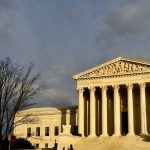Justices refuse to force refund of excessive bankruptcy fees

Share
Two years after the court ruled that a disparity in bankrupt debtors’ fees between judicial districts was impermissible, the justices on Friday ruled 6-3 that charging equal fees going forward is an adequate remedy for that disparity. The government will not have to pay back debtors who paid more than they would have in another district.
In most districts (88 out of the 94 federal judicial districts), Chapter 11 bankruptcy cases are administered by the Office of the United States Trustee, a component of the Department of Justice. For historical reasons involving politics at the time of the Bankruptcy Code’s enactment, six districts in Alabama and North Carolina do not participate in that system; they are administered by the Bankruptcy Administrator Program in the Administrative Office of the United States Courts. By statute, the U.S. Trustee charges user fees that cover its costs, so that taxpayers contribute nothing to run the bankruptcy system.
Traditionally, the Bankruptcy Administrator Program tracked the fees set by the U.S. Trustee program, but for a brief period from 2018 to 2021 it did not, so that businesses filing in Alabama and North Carolina for a time paid lower fees than businesses filing elsewhere. One of the businesses filing elsewhere complained, and the Supreme Court held in 2022 in Siegel v. Fitzgerald that the disparity violated the requirement of the Bankruptcy Clause of the Constitution that bankruptcy laws must be “uniform” “throughout the United States.”
The issue in Office of the United States Trustee v. John Q. Hammons Fall 2006, LLC was how to remedy the problem. John Q. Hammons is a business that filed in a high-fee district and wanted a refund of about $ 3 million in fees that it would not have paid had it been charged at the Alabama/North Carolina fee schedule. Justice Ketanji Brown Jackson’s opinion for a 6-3 majority denied that request for a refund.
Jackson started with the maxim that “the nature of the violation determines the scope of the remedy,” and she proceeded to discuss “[t]hree aspects of” the court’s decision in Siegel v. Fitzgerald are worth highlighting.” The first was that “the violation … was nonuniformity, not high fees”; accordingly, Jackson reasoned, “our task is not necessarily to reduce them; it is to remedy the disparity.” The second was that “the fee disparity … was short lived,” running only from 2018 to 2021. The third was that “the disparity was small,” affecting only 50 of more than 2,000 Chapter 11 cases that were filed in the low-fee districts.
Against that backdrop, Jackson wrote, the “touchstone for any decision about remedy is legislative intent.” Because this is a case “involving unequal treatment,” the court traditionally has a “focus on two considerations,” the “intensity of commitment [by Congress] to the more broadly applicable rule,” and “the degree of potential disruption” if the court “were to extend the deception.” Here, she noted, Congress’s intentions were “unmistakable.” Because Congress always intended “to impose equal fees in all districts,” Jackson concluded that Congress’s preference plainly would have been “prospective parity, not a refund or retrospective raising of fees.” Jackson emphasized Congress’s strong “commitment” to “keep[ing] the U.S. Trustee Program self-funded,” noting the statute’s explicit command that there be “no cost to the taxpayer.”
Jackson then turned to “the disruption that would follow” from the “flipside,” judicial “imposition of a refund.” Repeating government estimates of more than $ 300 million in required refunds, she found it “hard to imagine a remedy more diametrically opposed to clear congressional intent.” Morover, because a considerable number of the cases had closed, many “debtors have been liquidated or otherwise ceased to exist,” leaving “no meaningful path” to producing complete equiality. Returning again and again to congressional intent, Jackson characterized the “only real question” as “whether Congress would have wanted to retrospectively impose higher fees on debtors in [low-fee] districts, a remedy that she found equally impractical. Noting that “[o]ur remedial principles do not require us to follow that unintended, impractical course,” she concluded that “prospective parity … is sufficient to address the small, short-lived disparity caused by the constitutional violation we identified in Siegel.” That is the remedy that “Congress would have provided” and that is enough for the majority.
Justice Neil Gorsuch filed a forceful dissent, joined by Justices Clarence Thomas and Amy Coney Barrett. For Gorsuch, the court’s premise was entirely wrong, because the focus in remediation should not be on what Congress would want to do, he argued, but instead on what provides a sensible remedy for the injury in hand. For centuries, the court has held that “the appropriate remedy for duties or taxes erroneously … assessed is … restitution or compensation.” Those “longstanding precedents should,” in Gorsuch’s view, “make short work of this case.” The prospective remedy that the court adopted provided, Gorsuch wrote, no relief at all for the complaining filer here.
I find it a bit odd that the court is so persuaded that congressional intent should be the beginning and end in designing a remedy for an enactment that deprived business of their funds in violation of the Constitution. It seems, though, that the justices were strongly influenced by the apparent impossibility of designing any remedy that would produce true equality among filers.
The post Justices refuse to force refund of excessive bankruptcy fees appeared first on SCOTUSblog.
